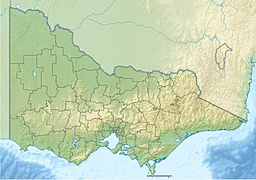Lake Corangamite facts for kids
Quick facts for kids Lake Corangamite |
|
|---|---|

Shoreline, southwest of Foxhow
|
|
| Location | Western District Lakes, Victoria |
| Coordinates | 38°10′51″S 143°24′16″E / 38.18083°S 143.40444°E |
| Type | Endorheic, hypersaline |
| Primary inflows |
|
| Primary outflows | evaporation |
| Catchment area | 4,079 km2 (1,575 sq mi) |
| Basin countries | Australia |
| Max. length | 150 km (93 mi) |
| Surface area | 234 km2 (90 sq mi) |
| Average depth | 5 m (16 ft) |
| Max. depth | 7 m (23 ft) |
| Islands | Vaughan Island |
Lake Corangamite is a very salty lake in south-west Victoria, Australia. It's near Colac, in an area known for its lakes and old volcanoes. This lake is endorheic, which means water flows into it but doesn't flow out to the ocean. Instead, the water leaves only by evaporation.
Lake Corangamite is Australia's largest permanent salty lake. It covers about 230 square kilometers and has a shoreline of 150 kilometers. It's part of the Ramsar-listed Western District Lakes, which are important wetlands. The local Indigenous name for the lake is Kronimite.
Contents
Lake Corangamite: Physical Features and Water Flow
Lake Corangamite is surrounded by interesting rocky areas. To the south and east, you'll find "stony rises." These were made by ancient lava flows from nearby volcanoes like Mount Porndon and Mount Warrion. The lava from Mount Warrion actually blocked the natural water flow, which helped create the lake.
How the Lake Formed and Changed
Like many lakes in this area, Lake Corangamite has special sand dunes called lunettes on its eastern side. These dunes formed when strong winds blew sediments from the lake during very dry periods.
The amount of water flowing into the lake changes a lot. In very dry years, hardly any water flows in. Because it's an endorheic lake, water only leaves by evaporating into the air. However, in the 1950s, there was a very wet period. The lake flooded and connected to other wetlands and even the Barwon River. The lake has never completely dried up since Europeans settled in Australia. There's even evidence it was connected to other waterways for centuries before the 1840s.
Water Sources and Salinity
The main streams that feed Lake Corangamite are Pirron Yaloak Creek, the Woady Yaloak River, and Salt Creek. Pirron Yaloak Creek flows from the Otway plains and carries a lot of nutrients from dairy farms in its area.
After the big floods in the 1950s, the Woady Yaloak River was redirected. Now, its water can be sent away from Lake Corangamite and into the Barwon River if the lake's water level gets too high. This diversion hasn't been needed in recent years because the lake's water levels have been dropping for decades. It's possible the lake could even dry up completely in the future. In 1980, the lake's saltiness was similar to seawater. Since then, it has become at least four times saltier than the ocean!
Animals of Lake Corangamite
Lake Corangamite has been home to many different animals, especially birds.
Fish and Other Water Creatures
In the past, the lake had fish like short-finned eels, common galaxias, flat-headed gudgeon, and small-mouth hardyhead. These fish might still live in places like Pirron Yaloak Creek or in freshwater springs around the lake. Some springs on the south-east side have dried up, possibly because too much water was taken from the Warrion Aquifer for irrigation. More recently, the lake has been home to tiny creatures like brine shrimp and a type of isopod.
Birds and Their Habitats
Lake Corangamite used to be a very important place for birds. It supported huge numbers of banded stilts. It was also a key breeding spot for many waterbirds. For example, pelican colonies used to live on Wool Wool rocks and Vaughan Island.
However, as the lake's water levels have dropped, the small creatures that birds eat have disappeared. Also, foxes have been able to reach the bird colonies, causing the birds to leave. Vaughan Island, which was once an important bird habitat, had its rocks and plants removed by its owner, even after receiving money for conservation. Because it sometimes supports so many waterbirds, Lake Corangamite is recognized as an Important Bird Area by BirdLife International.
World War II Aircraft Discovery
In June 2005, a crashed RAAF Wirraway plane from World War II was found in Lake Corangamite. This was exciting because Heritage Victoria protects all aircraft crash sites that are over 50 years old.
The plane was found when the lake's water levels went down, exposing the site. It is believed to be Wirraway A20-406, which crashed into the lake about 400 meters from shore on March 17, 1943. The site seems to be mostly untouched and is still partly underwater.


